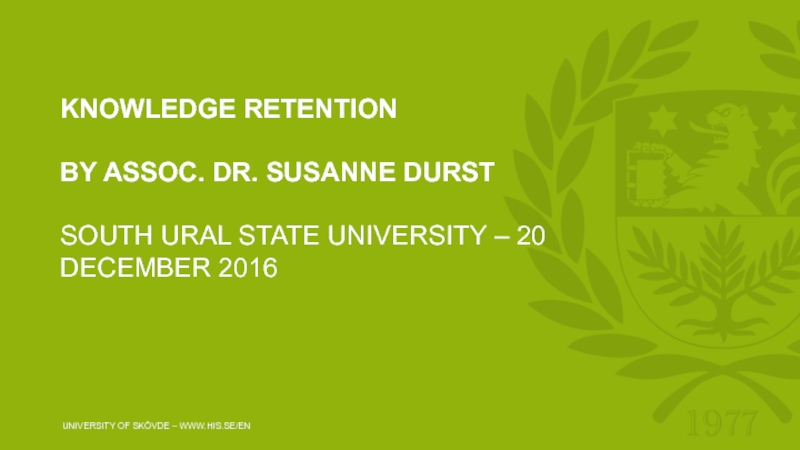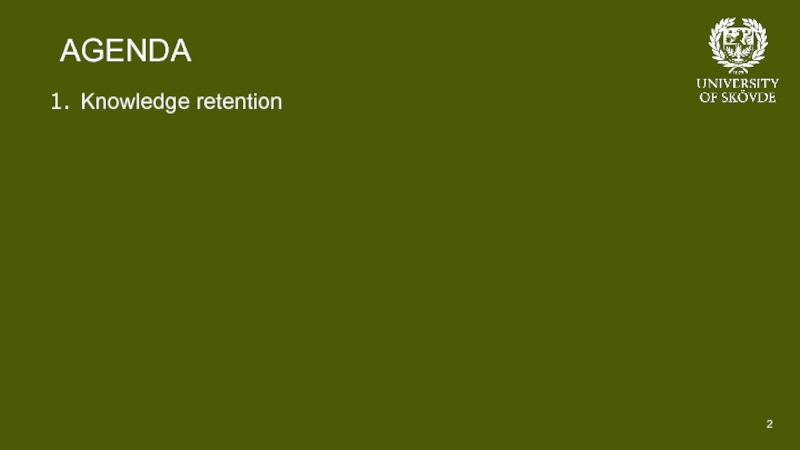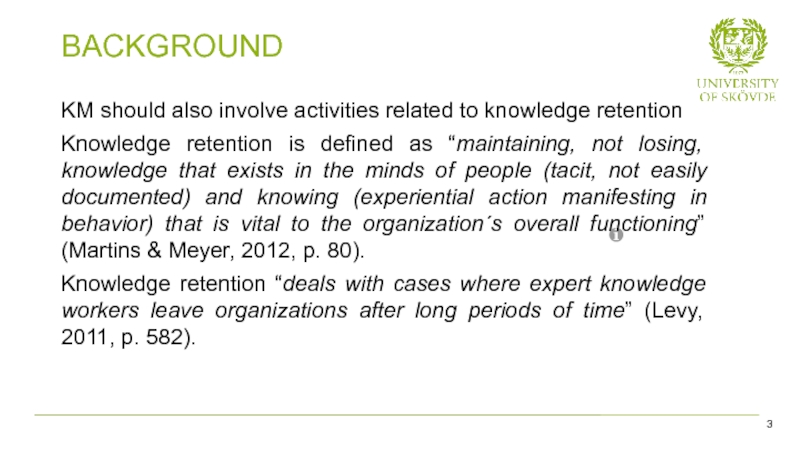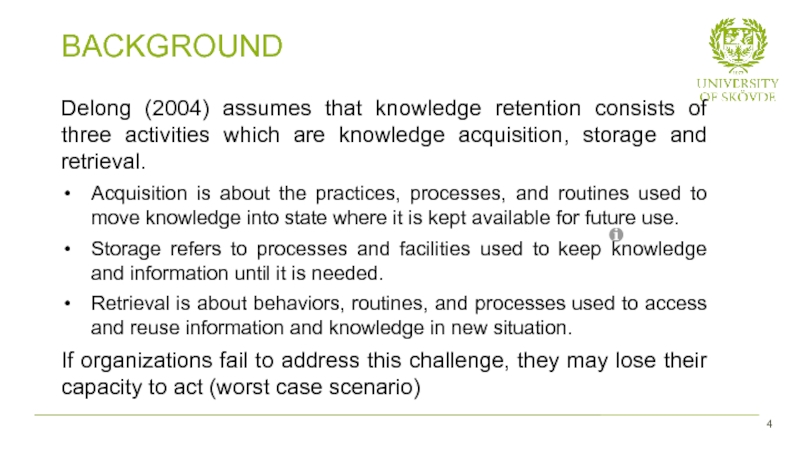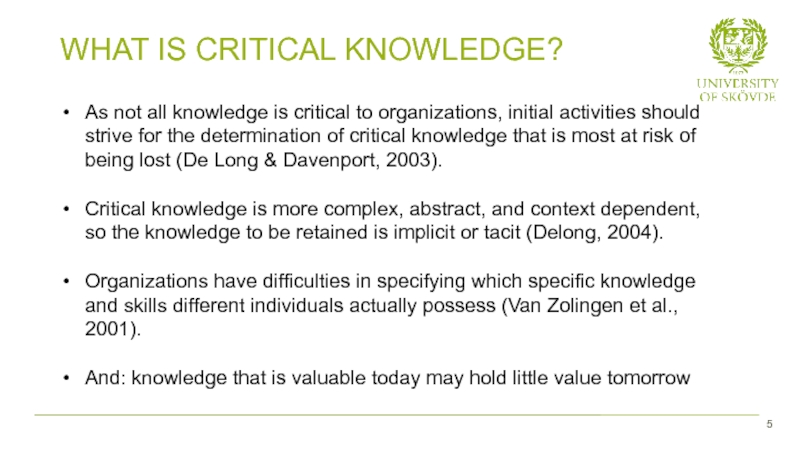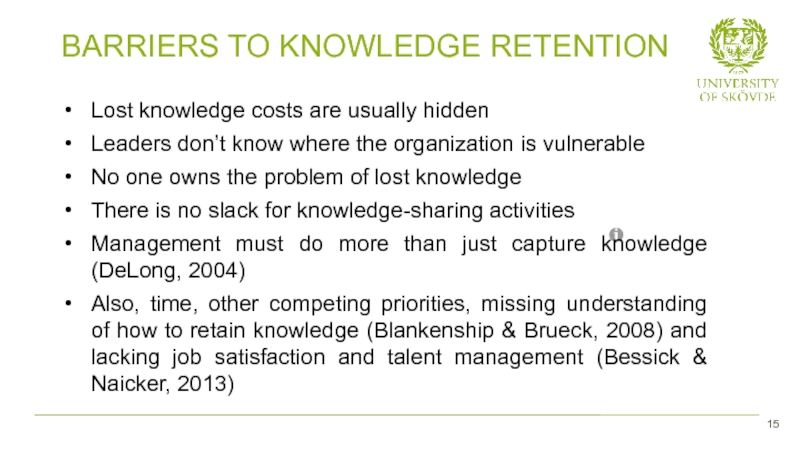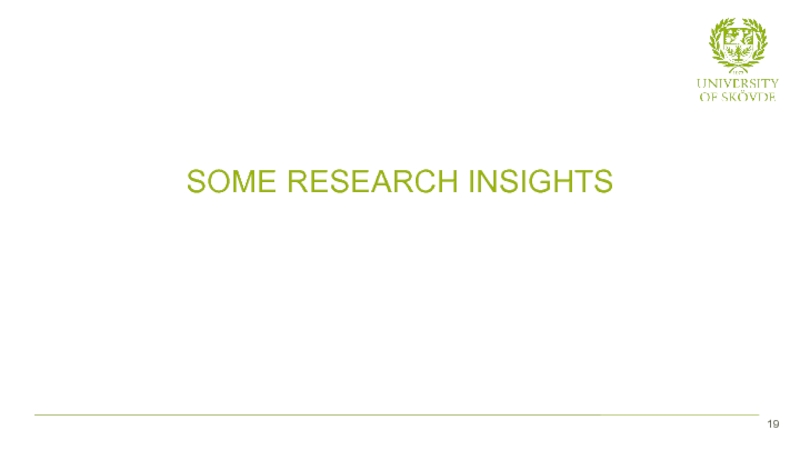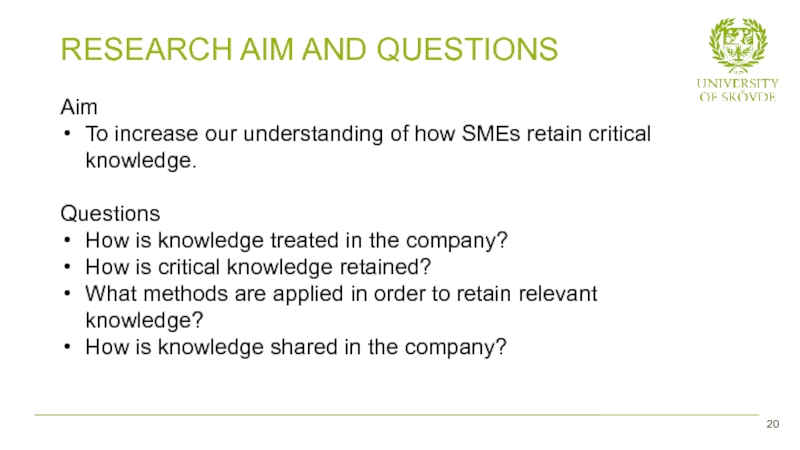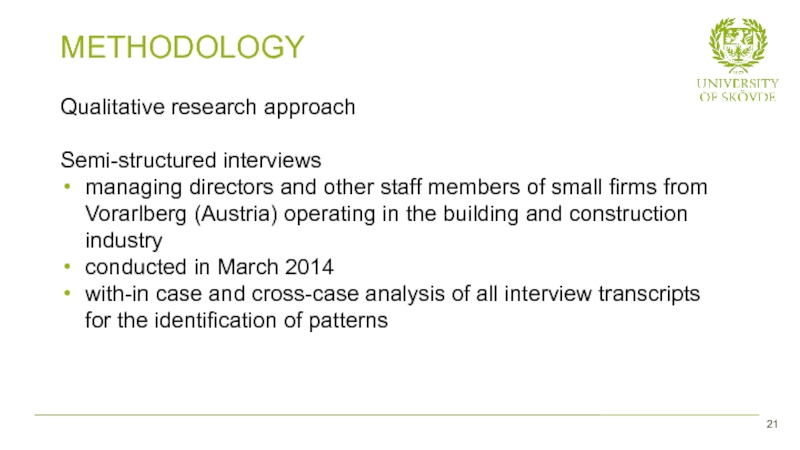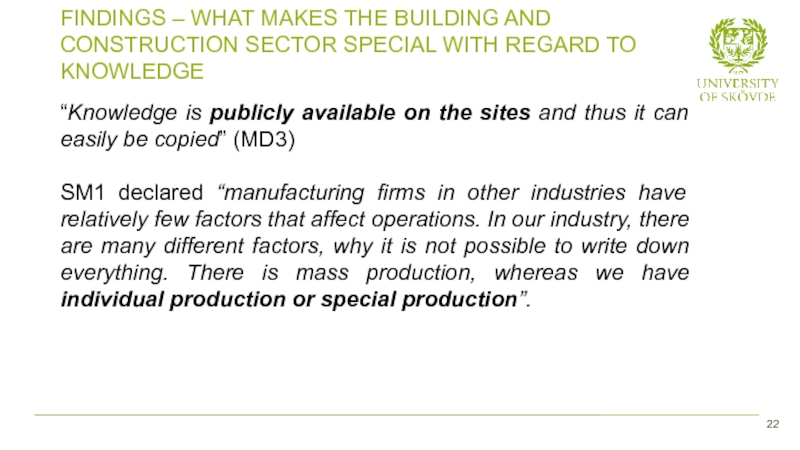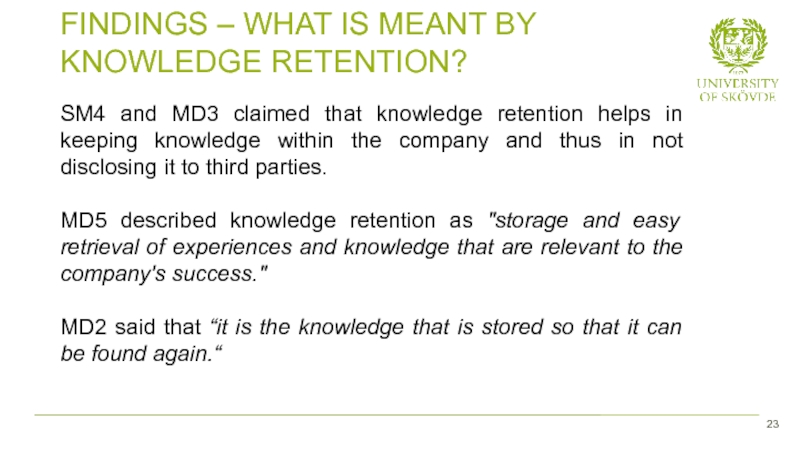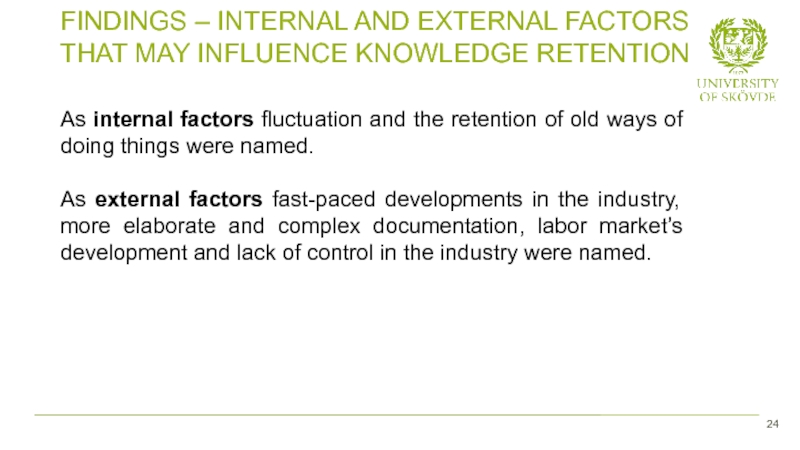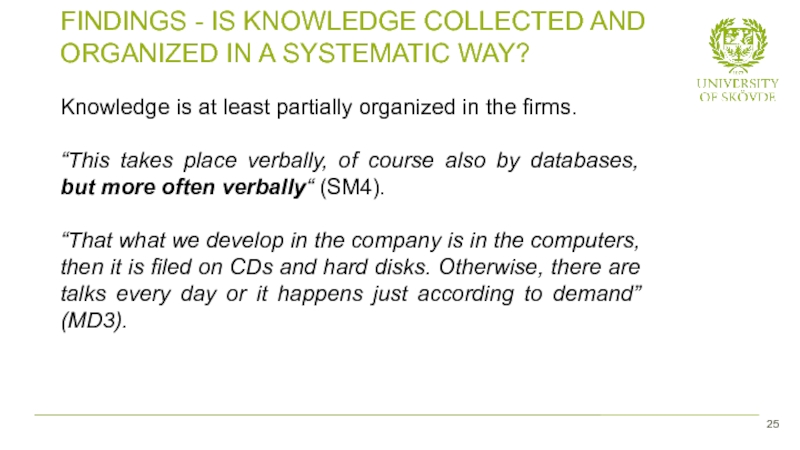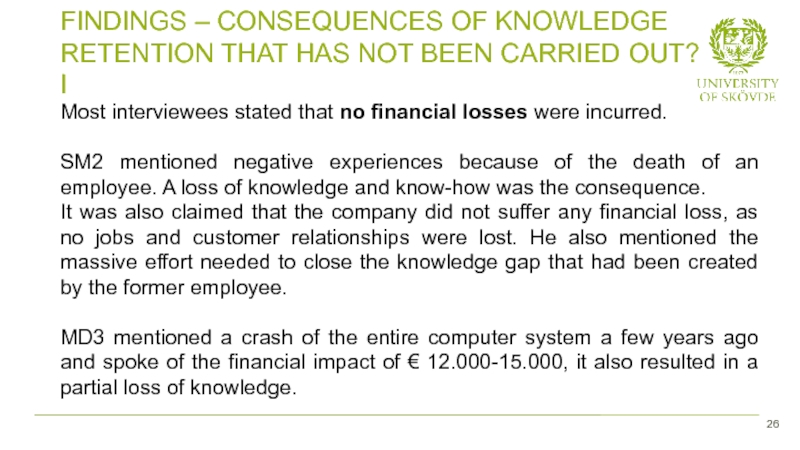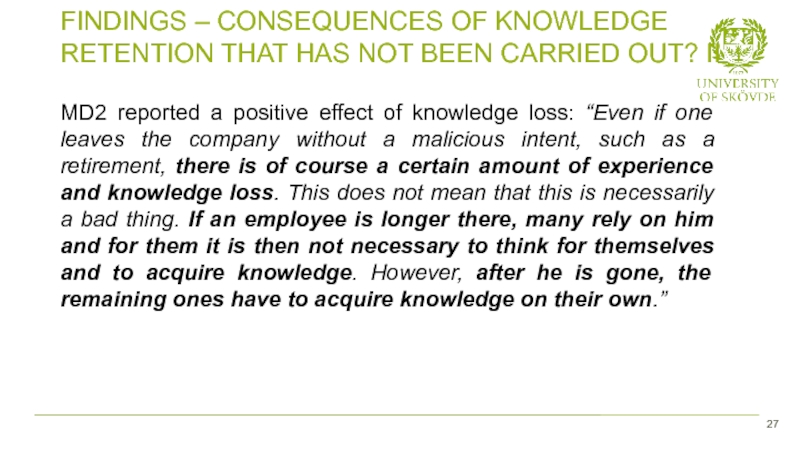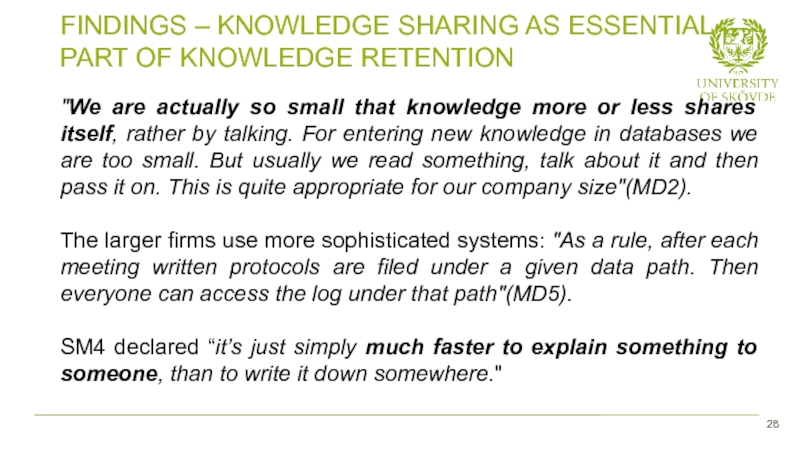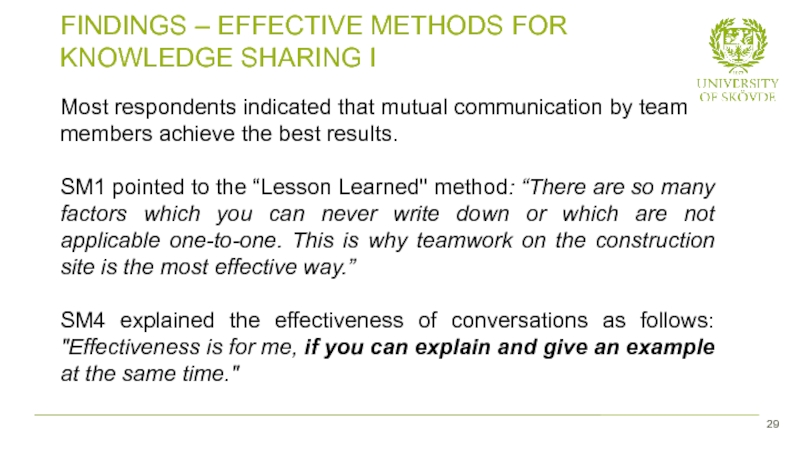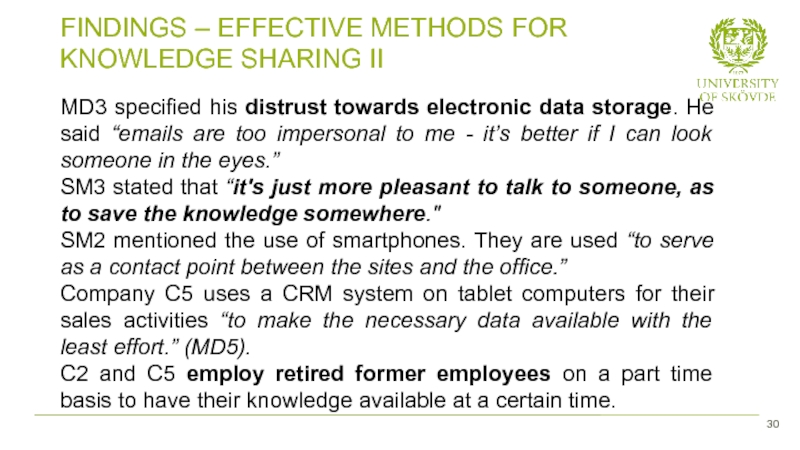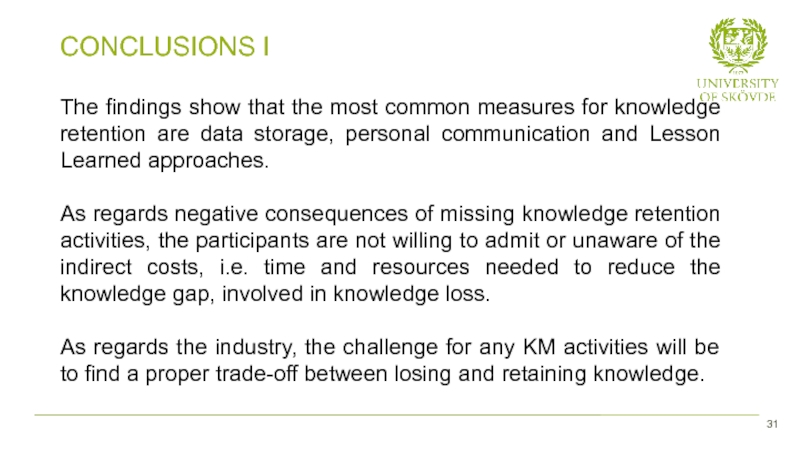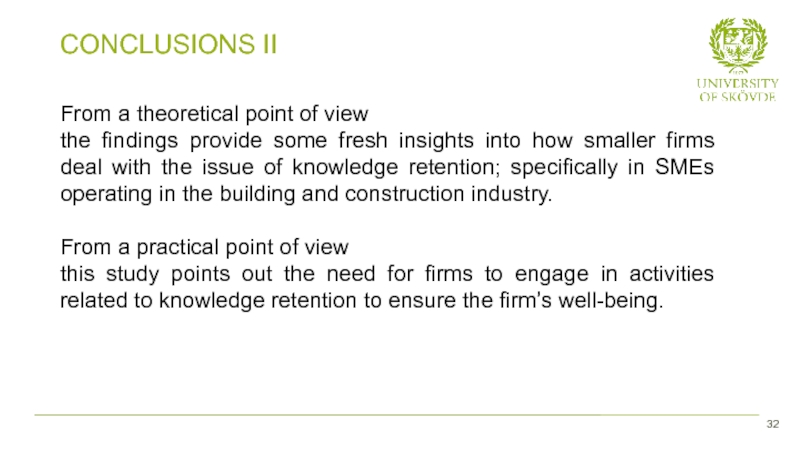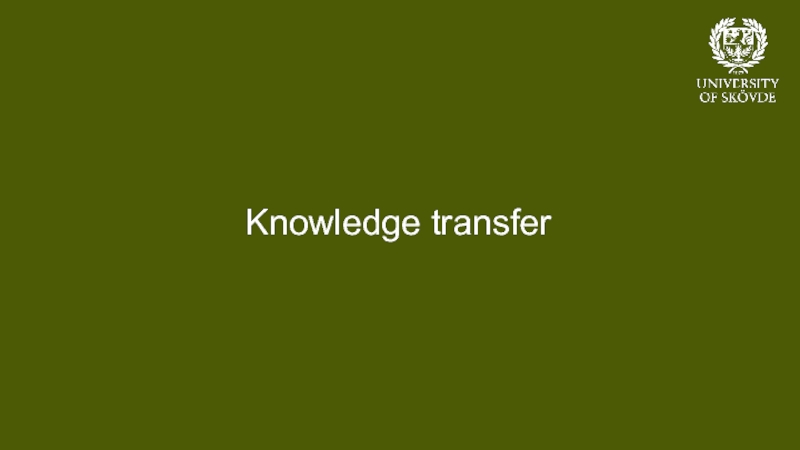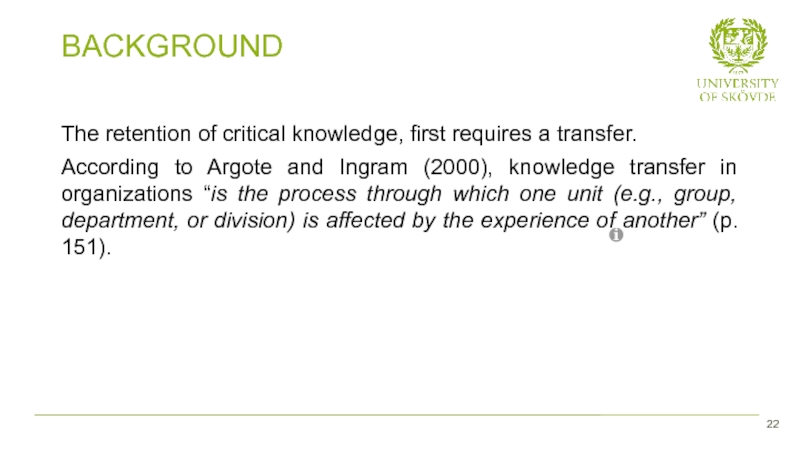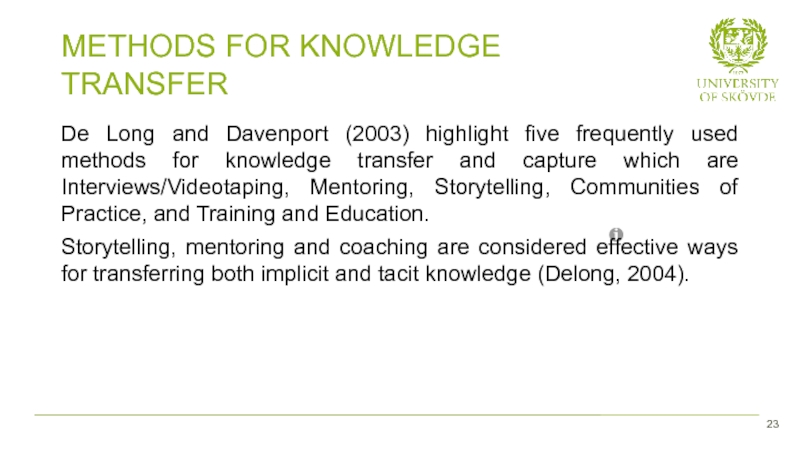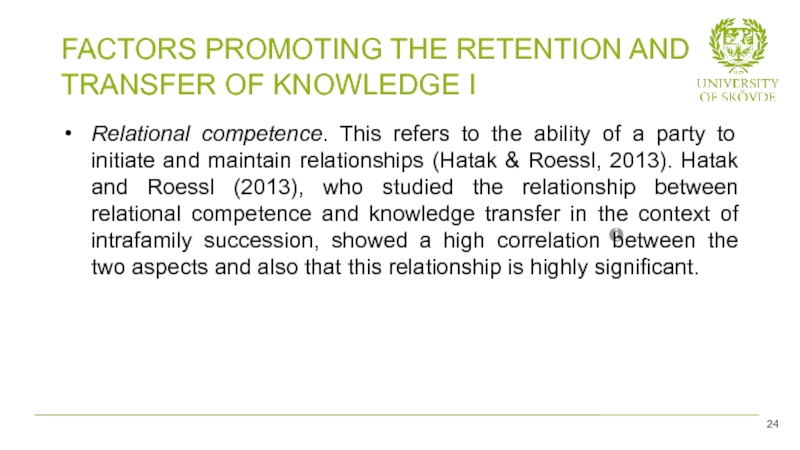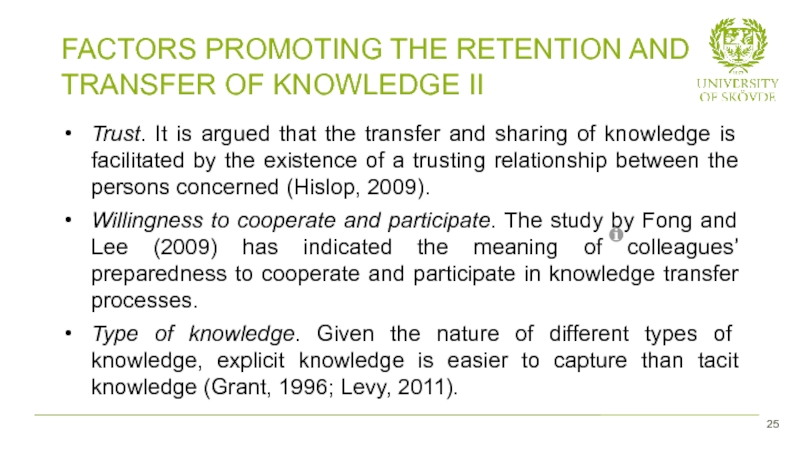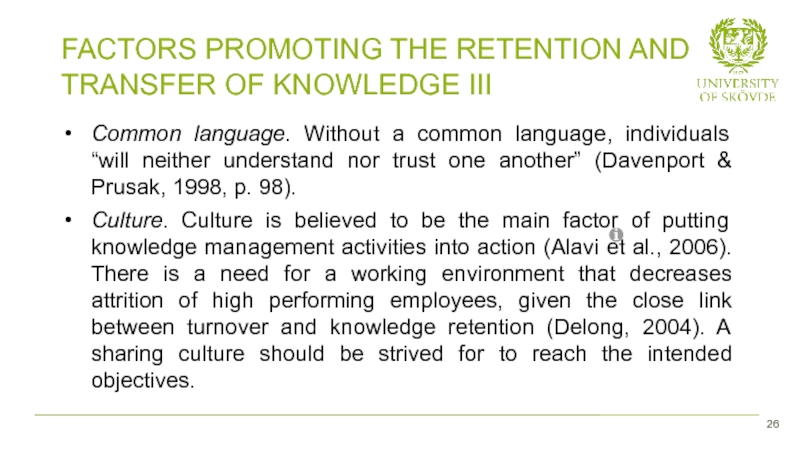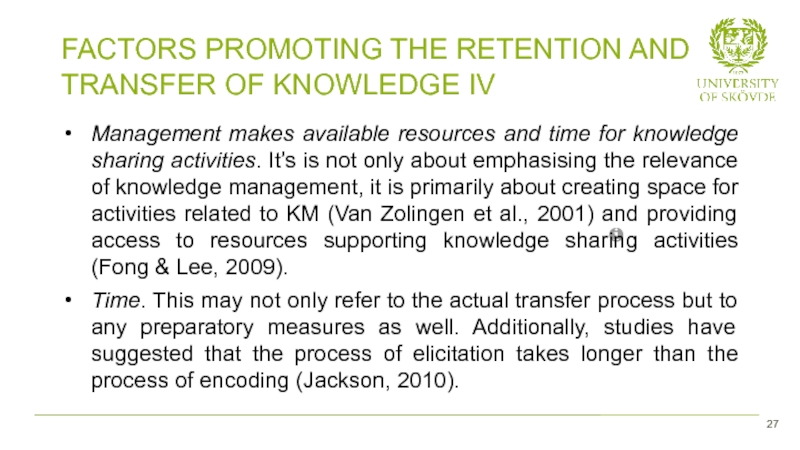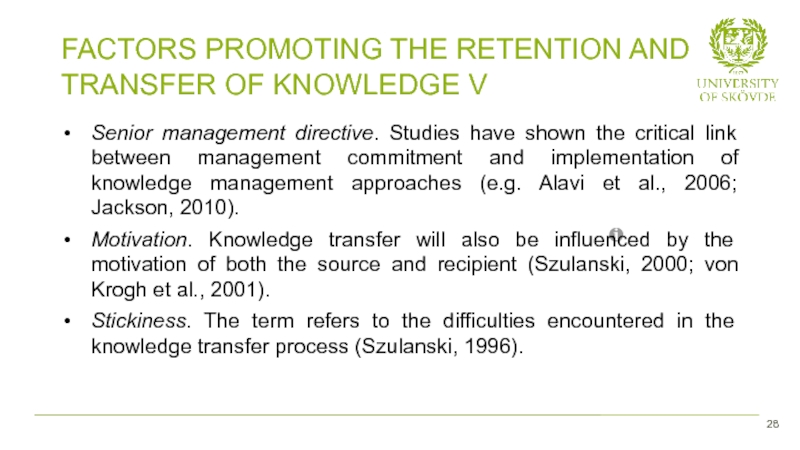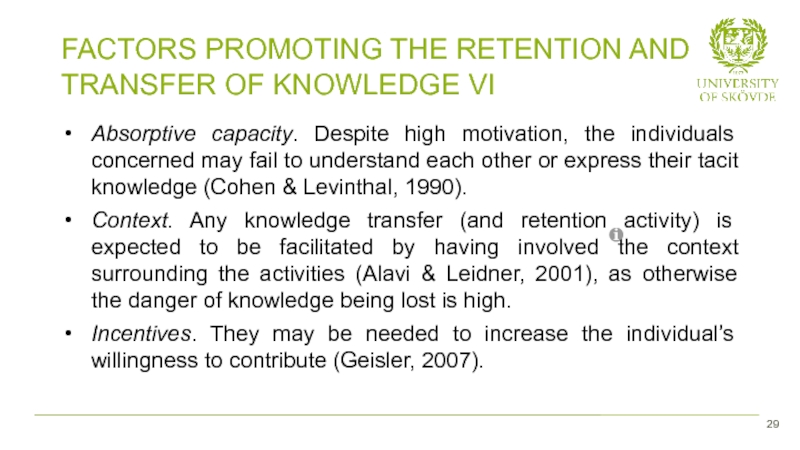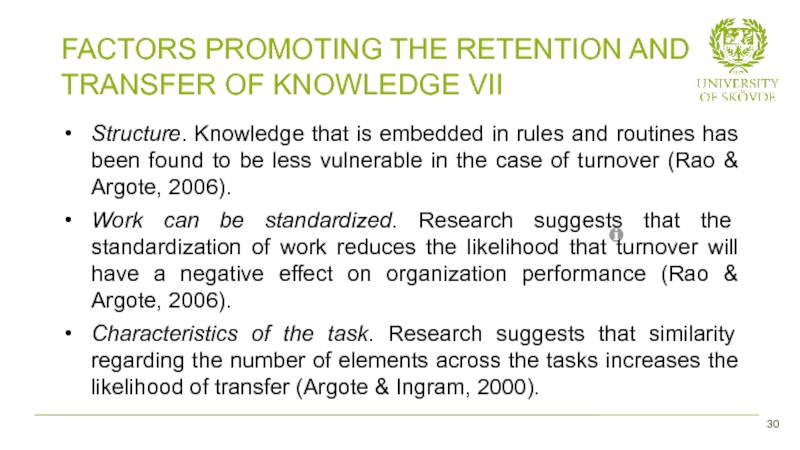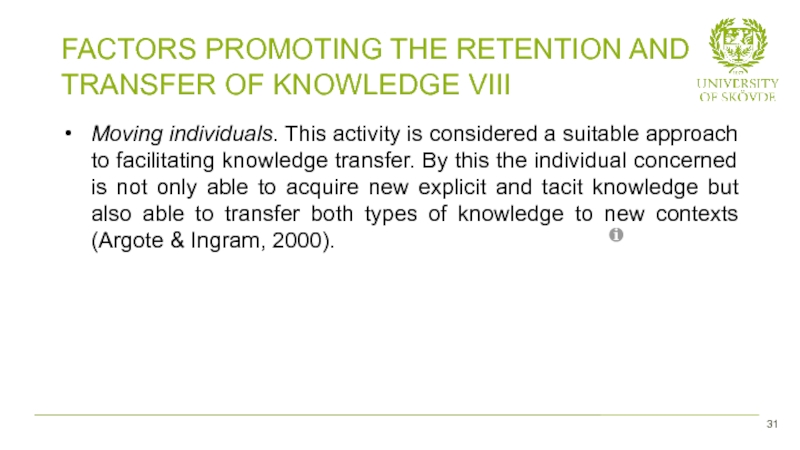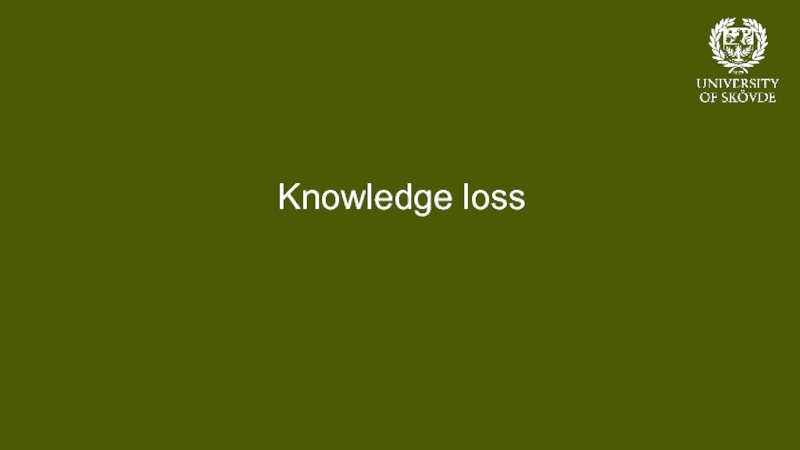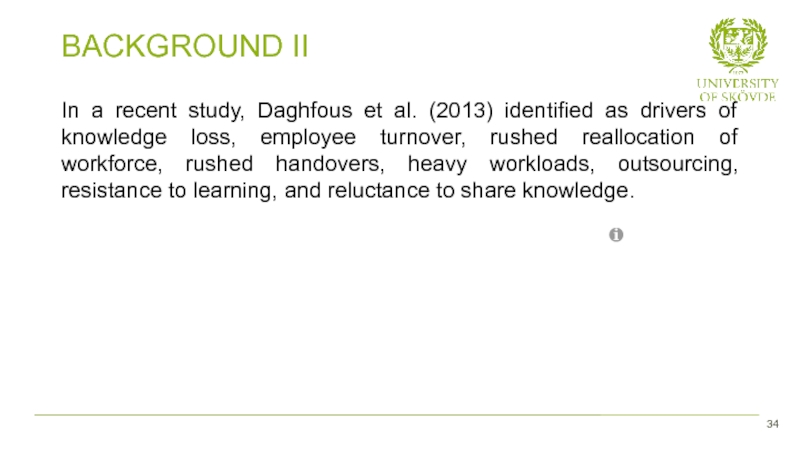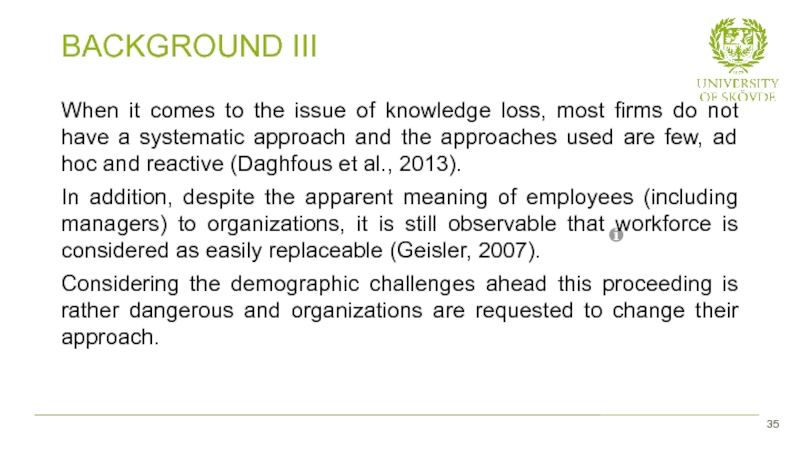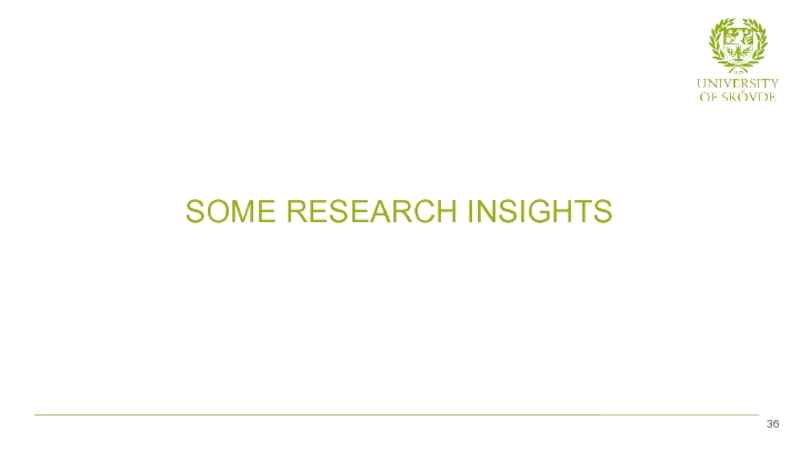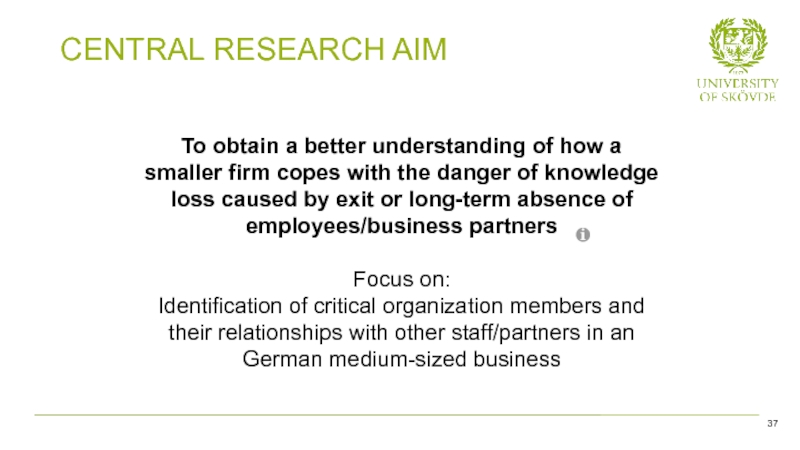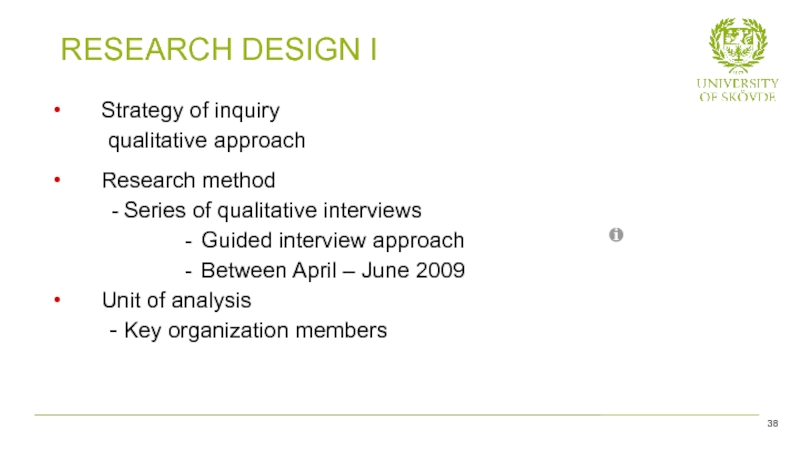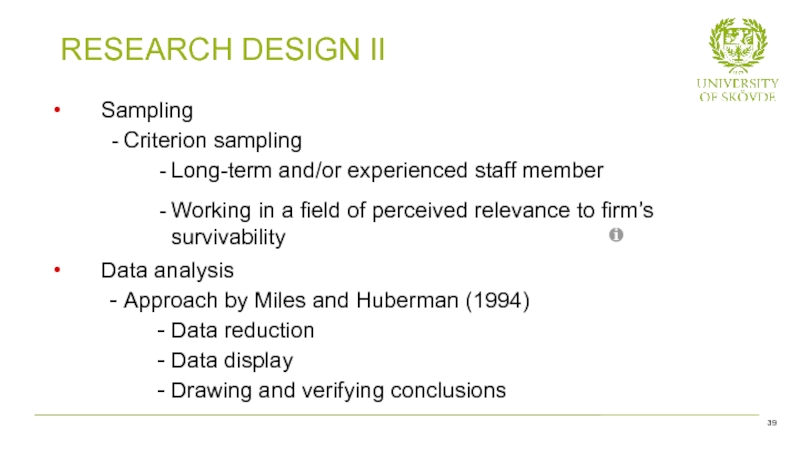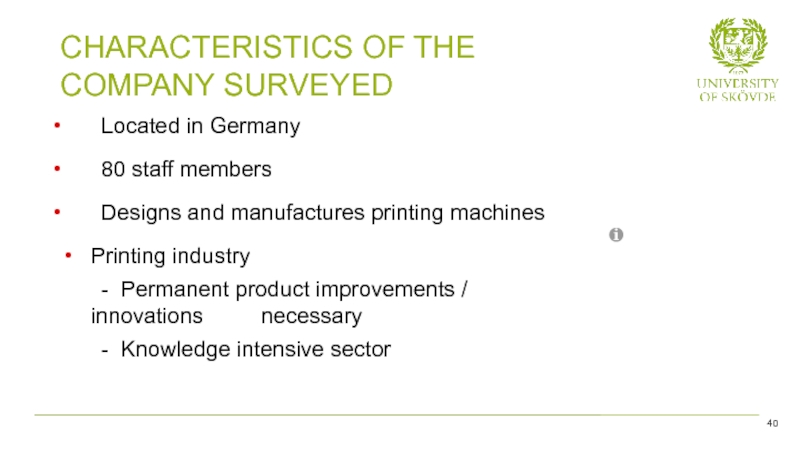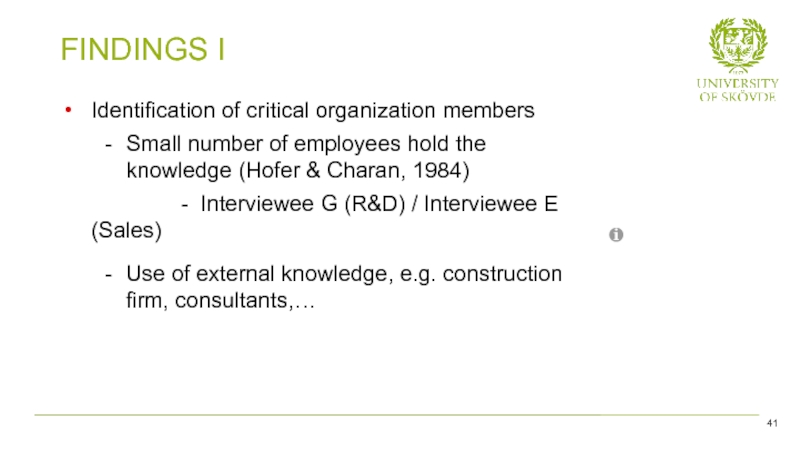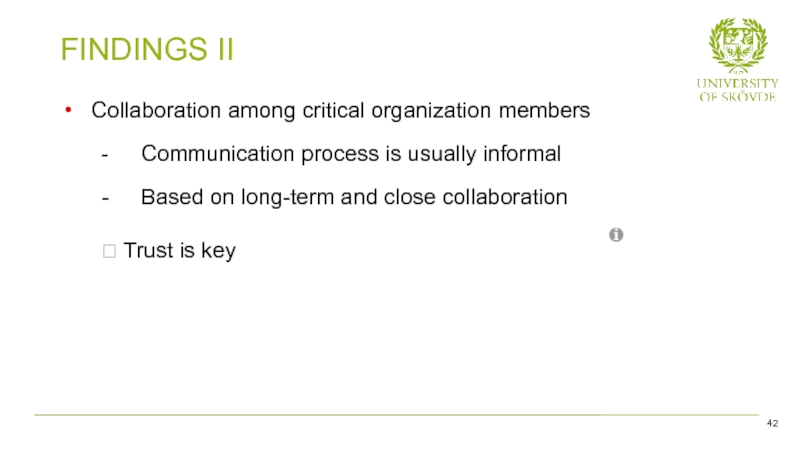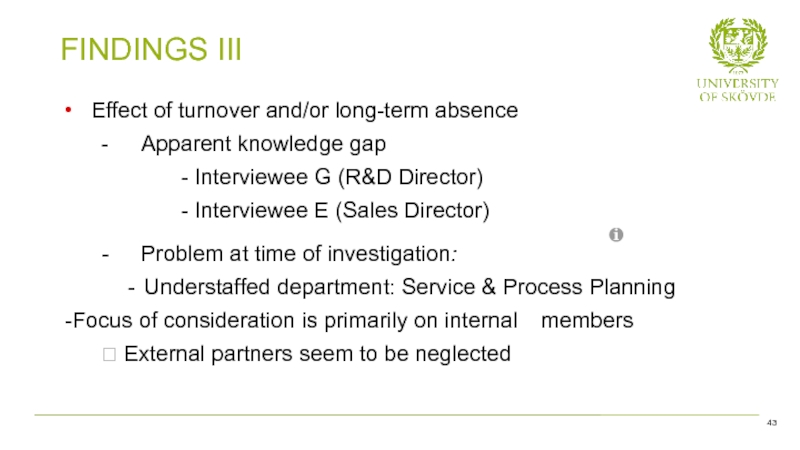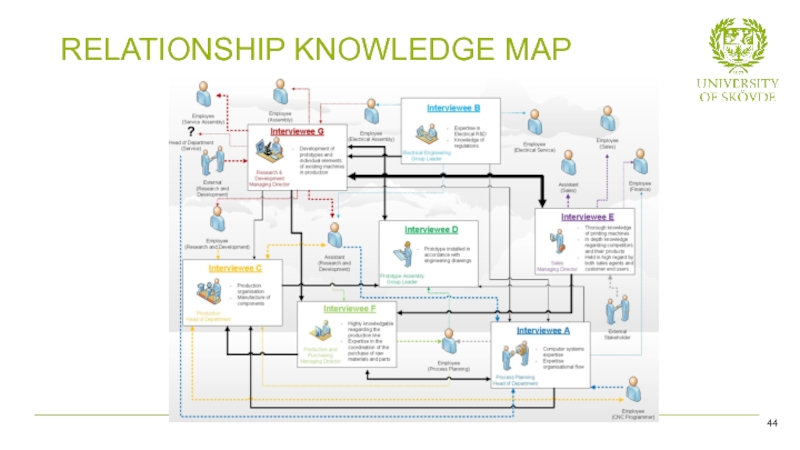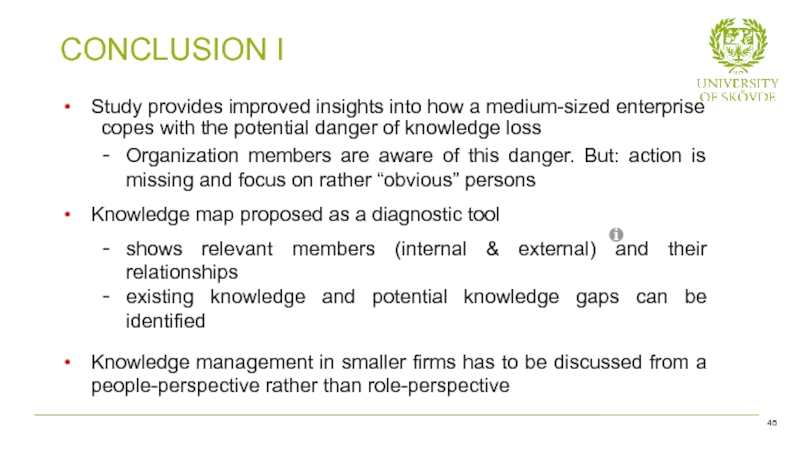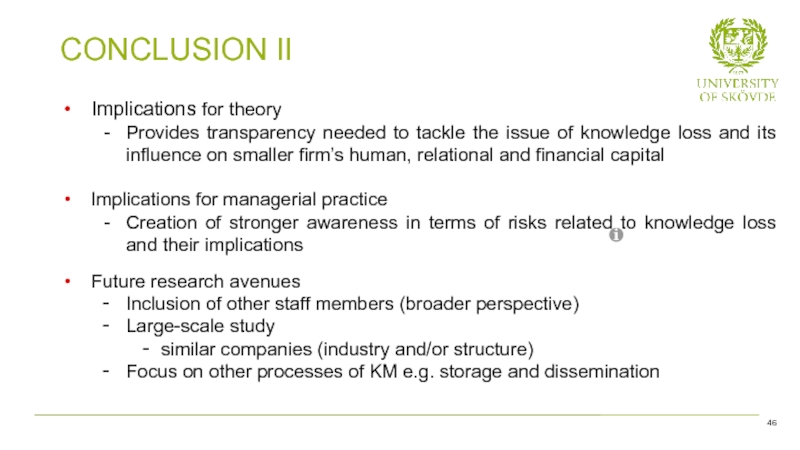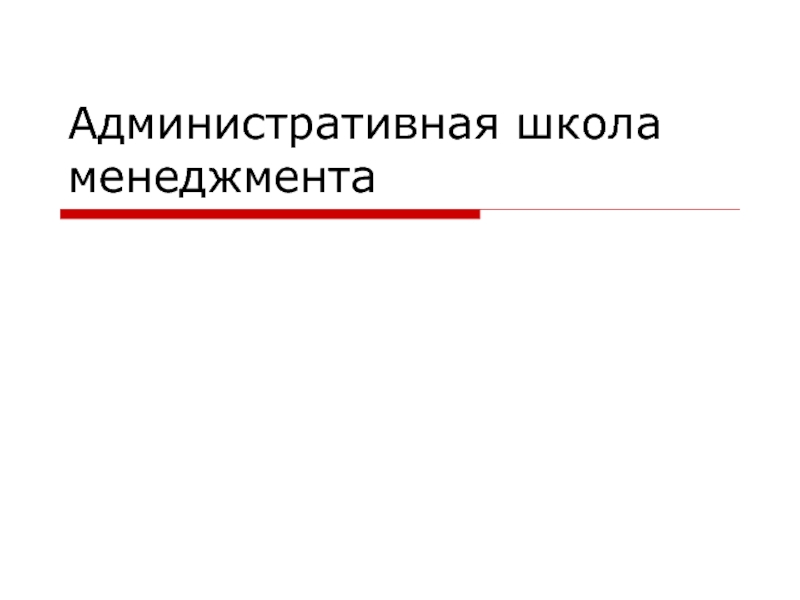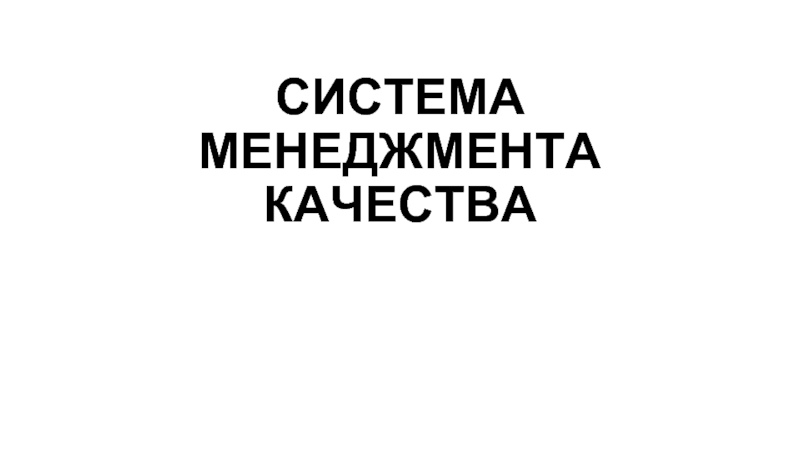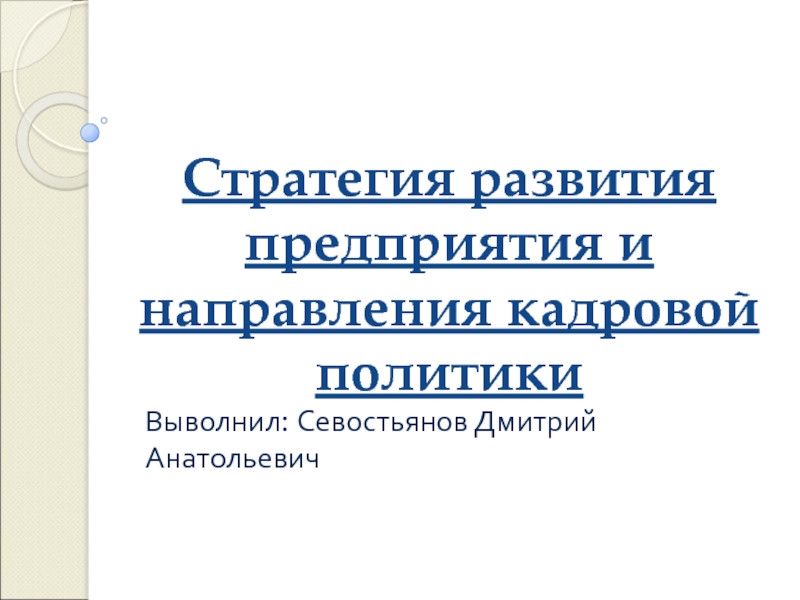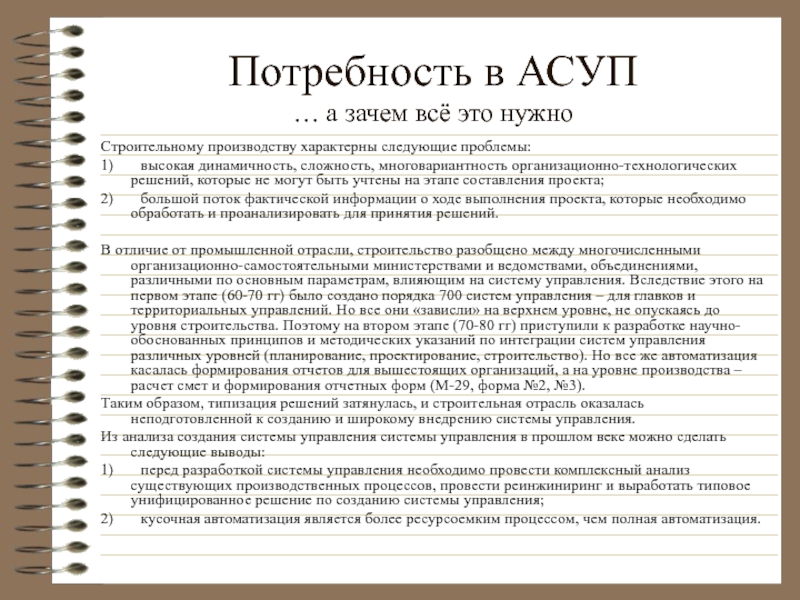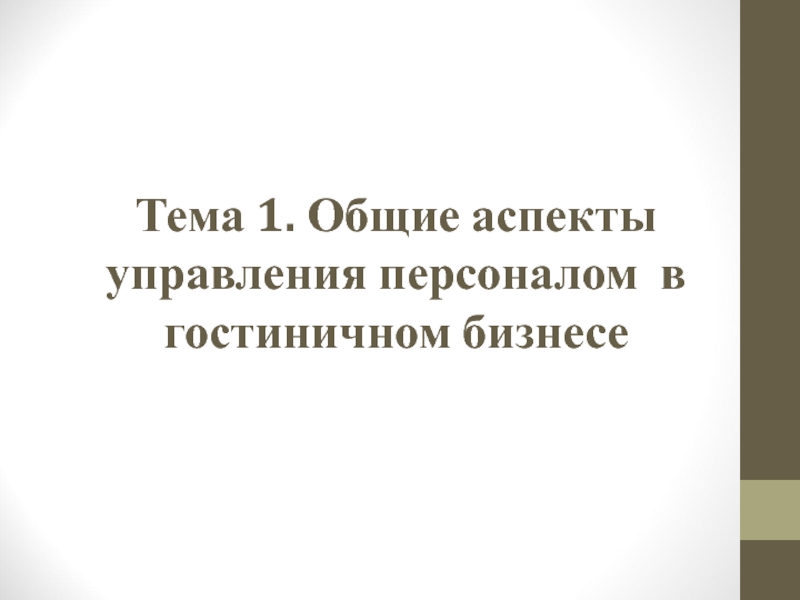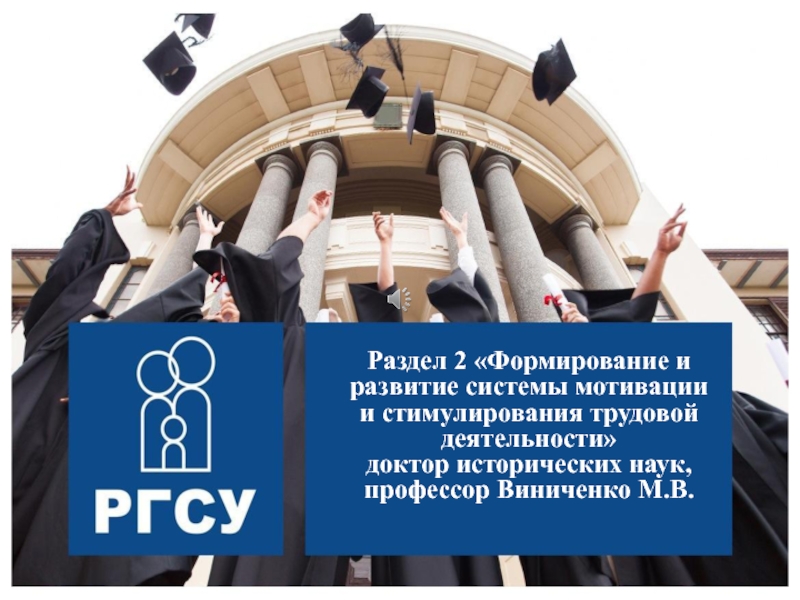UNIVERSITY OF SKÖVDE – WWW.HIS.SE/EN
- Главная
- Разное
- Дизайн
- Бизнес и предпринимательство
- Аналитика
- Образование
- Развлечения
- Красота и здоровье
- Финансы
- Государство
- Путешествия
- Спорт
- Недвижимость
- Армия
- Графика
- Культурология
- Еда и кулинария
- Лингвистика
- Английский язык
- Астрономия
- Алгебра
- Биология
- География
- Детские презентации
- Информатика
- История
- Литература
- Маркетинг
- Математика
- Медицина
- Менеджмент
- Музыка
- МХК
- Немецкий язык
- ОБЖ
- Обществознание
- Окружающий мир
- Педагогика
- Русский язык
- Технология
- Физика
- Философия
- Химия
- Шаблоны, картинки для презентаций
- Экология
- Экономика
- Юриспруденция
Knowledge retention. Dr. Susanne Durs презентация
Содержание
- 1. Knowledge retention. Dr. Susanne Durs
- 2. AGENDA 2 Knowledge retention
- 3. KM should also involve activities related
- 4. Delong (2004) assumes that knowledge retention
- 5. WHAT IS CRITICAL KNOWLEDGE? As not all
- 6. Lost knowledge costs are usually hidden
- 7. SOME RESEARCH INSIGHTS 19
- 8. Aim To increase our understanding of how
- 9. Qualitative research approach Semi-structured interviews managing
- 10. “Knowledge is publicly available on the sites
- 11. SM4 and MD3 claimed that knowledge retention
- 12. As internal factors fluctuation and the retention
- 13. Knowledge is at least partially organized in
- 14. Most interviewees stated that no financial losses
- 15. MD2 reported a positive effect of knowledge
- 16. "We are actually so small that knowledge
- 17. Most respondents indicated that mutual communication by
- 18. MD3 specified his distrust towards electronic data
- 19. The findings show that the most common
- 20. From a theoretical point of view
- 21. Knowledge transfer
- 22. The retention of critical knowledge, first
- 23. De Long and Davenport (2003) highlight
- 24. Relational competence. This refers to the
- 25. Trust. It is argued that the
- 26. Common language. Without a common language,
- 27. Management makes available resources and time
- 28. Senior management directive. Studies have shown
- 29. Absorptive capacity. Despite high motivation, the
- 30. Structure. Knowledge that is embedded in
- 31. Moving individuals. This activity is considered
- 32. Knowledge loss
- 33. Lost knowledge can occur at individual,
- 34. In a recent study, Daghfous et
- 35. When it comes to the issue
- 36. SOME RESEARCH INSIGHTS 36
- 37. CENTRAL RESEARCH AIM To obtain
- 38. RESEARCH DESIGN I Strategy
- 39. Sampling Criterion sampling Long-term
- 40. CHARACTERISTICS OF THE COMPANY SURVEYED
- 41. FINDINGS I Identification of critical
- 42. FINDINGS II Collaboration among critical
- 43. Effect of turnover and/or long-term absence
- 44. RELATIONSHIP KNOWLEDGE MAP
- 45. Study provides improved insights into how
- 46. Implications for theory Provides transparency needed
Слайд 1KNOWLEDGE RETENTION BY ASSOC. DR. SUSANNE DURST SOUTH URAL STATE UNIVERSITY – 20
Слайд 3
KM should also involve activities related to knowledge retention
Knowledge retention
Knowledge retention “deals with cases where expert knowledge workers leave organizations after long periods of time” (Levy, 2011, p. 582).
BACKGROUND
3
Слайд 4
Delong (2004) assumes that knowledge retention consists of three activities which
Acquisition is about the practices, processes, and routines used to move knowledge into state where it is kept available for future use.
Storage refers to processes and facilities used to keep knowledge and information until it is needed.
Retrieval is about behaviors, routines, and processes used to access and reuse information and knowledge in new situation.
If organizations fail to address this challenge, they may lose their capacity to act (worst case scenario)
BACKGROUND
4
Слайд 5WHAT IS CRITICAL KNOWLEDGE?
As not all knowledge is critical to organizations,
Critical knowledge is more complex, abstract, and context dependent, so the knowledge to be retained is implicit or tacit (Delong, 2004).
Organizations have difficulties in specifying which specific knowledge and skills different individuals actually possess (Van Zolingen et al., 2001).
And: knowledge that is valuable today may hold little value tomorrow
5
Слайд 6
Lost knowledge costs are usually hidden
Leaders don’t know where the organization
No one owns the problem of lost knowledge
There is no slack for knowledge-sharing activities
Management must do more than just capture knowledge (DeLong, 2004)
Also, time, other competing priorities, missing understanding of how to retain knowledge (Blankenship & Brueck, 2008) and lacking job satisfaction and talent management (Bessick & Naicker, 2013)
BARRIERS TO KNOWLEDGE RETENTION
15
Слайд 8Aim
To increase our understanding of how SMEs retain critical knowledge.
Questions
How
How is critical knowledge retained?
What methods are applied in order to retain relevant knowledge?
How is knowledge shared in the company?
RESEARCH AIM AND QUESTIONS
20
Слайд 9Qualitative research approach
Semi-structured interviews
managing directors and other staff members of small
conducted in March 2014
with-in case and cross-case analysis of all interview transcripts for the identification of patterns
METHODOLOGY
21
Слайд 10“Knowledge is publicly available on the sites and thus it can
SM1 declared “manufacturing firms in other industries have relatively few factors that affect operations. In our industry, there are many different factors, why it is not possible to write down everything. There is mass production, whereas we have individual production or special production”.
FINDINGS – WHAT MAKES THE BUILDING AND CONSTRUCTION SECTOR SPECIAL WITH REGARD TO KNOWLEDGE
22
Слайд 11SM4 and MD3 claimed that knowledge retention helps in keeping knowledge
MD5 described knowledge retention as "storage and easy retrieval of experiences and knowledge that are relevant to the company's success."
MD2 said that “it is the knowledge that is stored so that it can be found again.“
FINDINGS – WHAT IS MEANT BY KNOWLEDGE RETENTION?
23
Слайд 12As internal factors fluctuation and the retention of old ways of
As external factors fast-paced developments in the industry, more elaborate and complex documentation, labor market’s development and lack of control in the industry were named.
FINDINGS – INTERNAL AND EXTERNAL FACTORS THAT MAY INFLUENCE KNOWLEDGE RETENTION
24
Слайд 13Knowledge is at least partially organized in the firms.
“This takes
“That what we develop in the company is in the computers, then it is filed on CDs and hard disks. Otherwise, there are talks every day or it happens just according to demand” (MD3).
FINDINGS - IS KNOWLEDGE COLLECTED AND ORGANIZED IN A SYSTEMATIC WAY?
25
Слайд 14Most interviewees stated that no financial losses were incurred.
SM2 mentioned
It was also claimed that the company did not suffer any financial loss, as no jobs and customer relationships were lost. He also mentioned the massive effort needed to close the knowledge gap that had been created by the former employee.
MD3 mentioned a crash of the entire computer system a few years ago and spoke of the financial impact of € 12.000-15.000, it also resulted in a partial loss of knowledge.
FINDINGS – CONSEQUENCES OF KNOWLEDGE RETENTION THAT HAS NOT BEEN CARRIED OUT? I
26
Слайд 15MD2 reported a positive effect of knowledge loss: “Even if one
FINDINGS – CONSEQUENCES OF KNOWLEDGE RETENTION THAT HAS NOT BEEN CARRIED OUT? II
27
Слайд 16"We are actually so small that knowledge more or less shares
The larger firms use more sophisticated systems: "As a rule, after each meeting written protocols are filed under a given data path. Then everyone can access the log under that path"(MD5).
SM4 declared “it’s just simply much faster to explain something to someone, than to write it down somewhere."
FINDINGS – KNOWLEDGE SHARING AS ESSENTIAL PART OF KNOWLEDGE RETENTION
28
Слайд 17Most respondents indicated that mutual communication by team members achieve the
SM1 pointed to the “Lesson Learned" method: “There are so many factors which you can never write down or which are not applicable one-to-one. This is why teamwork on the construction site is the most effective way.”
SM4 explained the effectiveness of conversations as follows: "Effectiveness is for me, if you can explain and give an example at the same time."
FINDINGS – EFFECTIVE METHODS FOR KNOWLEDGE SHARING I
29
Слайд 18MD3 specified his distrust towards electronic data storage. He said “emails
SM3 stated that “it's just more pleasant to talk to someone, as to save the knowledge somewhere."
SM2 mentioned the use of smartphones. They are used “to serve as a contact point between the sites and the office.”
Company C5 uses a CRM system on tablet computers for their sales activities “to make the necessary data available with the least effort.” (MD5).
C2 and C5 employ retired former employees on a part time basis to have their knowledge available at a certain time.
FINDINGS – EFFECTIVE METHODS FOR KNOWLEDGE SHARING II
30
Слайд 19The findings show that the most common measures for knowledge retention
As regards negative consequences of missing knowledge retention activities, the participants are not willing to admit or unaware of the indirect costs, i.e. time and resources needed to reduce the knowledge gap, involved in knowledge loss.
As regards the industry, the challenge for any KM activities will be to find a proper trade-off between losing and retaining knowledge.
CONCLUSIONS I
31
Слайд 20From a theoretical point of view
the findings provide some fresh
From a practical point of view
this study points out the need for firms to engage in activities related to knowledge retention to ensure the firm’s well-being.
CONCLUSIONS II
32
Слайд 22
The retention of critical knowledge, first requires a transfer.
According to Argote
BACKGROUND
22
Слайд 23
De Long and Davenport (2003) highlight five frequently used methods for
Storytelling, mentoring and coaching are considered effective ways for transferring both implicit and tacit knowledge (Delong, 2004).
METHODS FOR KNOWLEDGE TRANSFER
23
Слайд 24
Relational competence. This refers to the ability of a party to
FACTORS PROMOTING THE RETENTION AND TRANSFER OF KNOWLEDGE I
24
Слайд 25
Trust. It is argued that the transfer and sharing of knowledge
Willingness to cooperate and participate. The study by Fong and Lee (2009) has indicated the meaning of colleagues’ preparedness to cooperate and participate in knowledge transfer processes.
Type of knowledge. Given the nature of different types of knowledge, explicit knowledge is easier to capture than tacit knowledge (Grant, 1996; Levy, 2011).
FACTORS PROMOTING THE RETENTION AND TRANSFER OF KNOWLEDGE II
25
Слайд 26
Common language. Without a common language, individuals “will neither understand nor
Culture. Culture is believed to be the main factor of putting knowledge management activities into action (Alavi et al., 2006). There is a need for a working environment that decreases attrition of high performing employees, given the close link between turnover and knowledge retention (Delong, 2004). A sharing culture should be strived for to reach the intended objectives.
FACTORS PROMOTING THE RETENTION AND TRANSFER OF KNOWLEDGE III
26
Слайд 27
Management makes available resources and time for knowledge sharing activities. It’s
Time. This may not only refer to the actual transfer process but to any preparatory measures as well. Additionally, studies have suggested that the process of elicitation takes longer than the process of encoding (Jackson, 2010).
FACTORS PROMOTING THE RETENTION AND TRANSFER OF KNOWLEDGE IV
27
Слайд 28
Senior management directive. Studies have shown the critical link between management
Motivation. Knowledge transfer will also be influenced by the motivation of both the source and recipient (Szulanski, 2000; von Krogh et al., 2001).
Stickiness. The term refers to the difficulties encountered in the knowledge transfer process (Szulanski, 1996).
FACTORS PROMOTING THE RETENTION AND TRANSFER OF KNOWLEDGE V
28
Слайд 29
Absorptive capacity. Despite high motivation, the individuals concerned may fail to
Context. Any knowledge transfer (and retention activity) is expected to be facilitated by having involved the context surrounding the activities (Alavi & Leidner, 2001), as otherwise the danger of knowledge being lost is high.
Incentives. They may be needed to increase the individual’s willingness to contribute (Geisler, 2007).
FACTORS PROMOTING THE RETENTION AND TRANSFER OF KNOWLEDGE VI
29
Слайд 30
Structure. Knowledge that is embedded in rules and routines has been
Work can be standardized. Research suggests that the standardization of work reduces the likelihood that turnover will have a negative effect on organization performance (Rao & Argote, 2006).
Characteristics of the task. Research suggests that similarity regarding the number of elements across the tasks increases the likelihood of transfer (Argote & Ingram, 2000).
FACTORS PROMOTING THE RETENTION AND TRANSFER OF KNOWLEDGE VII
30
Слайд 31
Moving individuals. This activity is considered a suitable approach to facilitating
FACTORS PROMOTING THE RETENTION AND TRANSFER OF KNOWLEDGE VIII
31
Слайд 33
Lost knowledge can occur at individual, group, or organizational levels, have
DeLong further specifies five ways as to how lost knowledge can undermine organizational strategies:
a) Reduced capacity to innovate;
b) Ability to pursue growth strategies threatened;
c) Reduced efficiency undermines low-cost strategies;
d) Losing knowledge can give competitors an advantage;
e) Losing specific knowledge at the wrong time increases vulnerability.
BACKGROUND I
33
Слайд 34
In a recent study, Daghfous et al. (2013) identified as drivers
BACKGROUND II
34
Слайд 35
When it comes to the issue of knowledge loss, most firms
In addition, despite the apparent meaning of employees (including managers) to organizations, it is still observable that workforce is considered as easily replaceable (Geisler, 2007).
Considering the demographic challenges ahead this proceeding is rather dangerous and organizations are requested to change their approach.
BACKGROUND III
35
Слайд 37CENTRAL RESEARCH AIM
To obtain a better understanding of how a smaller
Focus on:
Identification of critical organization members and their relationships with other staff/partners in an German medium-sized business
Слайд 38RESEARCH DESIGN I
Strategy of inquiry
qualitative approach
Research method
Series of qualitative
Guided interview approach
Between April – June 2009
Unit of analysis
Key organization members
Слайд 39
Sampling
Criterion sampling
Long-term and/or experienced staff member
Working in a field
Data analysis
Approach by Miles and Huberman (1994)
Data reduction
Data display
Drawing and verifying conclusions
RESEARCH DESIGN II
Слайд 40CHARACTERISTICS OF THE COMPANY SURVEYED
Located in Germany
80 staff members
Designs and manufactures printing machines
Printing industry
- Permanent product improvements / innovations necessary
- Knowledge intensive sector
Слайд 41FINDINGS I
Identification of critical organization members
Small number of employees hold the
- Interviewee G (R&D) / Interviewee E (Sales)
Use of external knowledge, e.g. construction firm, consultants,…
Слайд 42FINDINGS II
Collaboration among critical organization members
- Communication process is usually informal
-
? Trust is key
Слайд 43
Effect of turnover and/or long-term absence
- Apparent knowledge gap
- Interviewee
- Interviewee E (Sales Director)
- Problem at time of investigation:
Understaffed department: Service & Process Planning
Focus of consideration is primarily on internal members
? External partners seem to be neglected
FINDINGS III
Слайд 45
Study provides improved insights into how a medium-sized enterprise
copes with the
Organization members are aware of this danger. But: action is missing and focus on rather “obvious” persons
Knowledge map proposed as a diagnostic tool
shows relevant members (internal & external) and their relationships
existing knowledge and potential knowledge gaps can be identified
Knowledge management in smaller firms has to be discussed from a people-perspective rather than role-perspective
CONCLUSION I
Слайд 46
Implications for theory
Provides transparency needed to tackle the issue of knowledge
Implications for managerial practice
Creation of stronger awareness in terms of risks related to knowledge loss and their implications
Future research avenues
Inclusion of other staff members (broader perspective)
Large-scale study
similar companies (industry and/or structure)
Focus on other processes of KM e.g. storage and dissemination
CONCLUSION II
